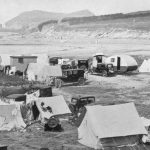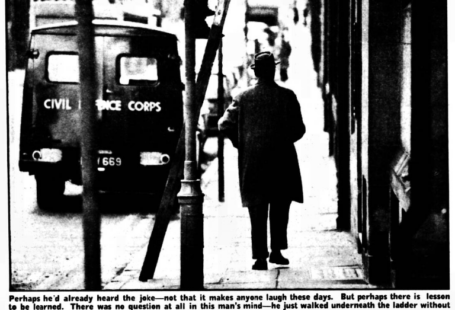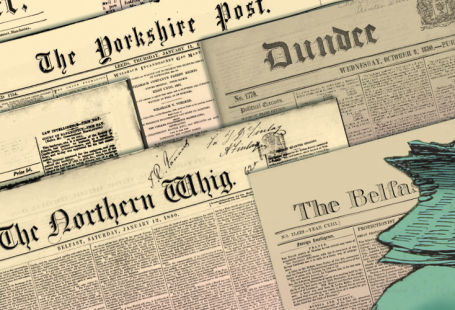This week at The Archive we are delighted to welcome 60,552 brand new pages to our collection, with the addition of a very special early London daily title, as well as extensive updates to some of our existing publications.
So read on to discover more about this week’s new title – the Morning Herald (London) – as well as to find out which of our newspaper holdings we have updated. Meanwhile, you can also discover more about early nineteenth century daredevil balloonist André-Jacques Garnerin, and how he and his exploits took London by storm in the summer of 1802.
Register now and explore the Archive
So without any further ado we’d like to introduce the Morning Herald (London) to you this week. An early daily newspaper, it was founded in London by the Reverend Sir Henry Bate Dudley, a former editor of the Morning Post, in 1780.
Initially positioned as a Liberal paper, it later aligned itself with the Tory party. In the early 1800s the Morning Herald would set you back 6d, and it featured the latest parliamentary intelligence. It also contained a range of advertisements, from ‘Amusements for Winter Evenings,’ to a ‘Valuable Discovery in Medicine,’ namely ‘Dr. Silby’s Re-Animating Solartincture – or Pabulum of Life.’
Morning Herald (London) | 22 December 1801
Meanwhile, its pages also contained such features as ‘Female Fashions’ for the month, society news and gossip, the naval register, as well as birth, marriage and death notices. Of particular interest is the section entitled ‘Want Places,’ which features advertisements from people searching for jobs.
In 1843 the Morning Herald was bought by Edward Baldwin, and upon his death in 1848 it was taken over by James Johnstone, the owner of the Evening Standard. Johnstone charged 4d for the Herald, with the Standard costing less at 2d. He also created an Evening Herald as a companion for his new acquisition, but sadly neither turned a profit, and the Morning Herald was eventually closed in 1869.
This week we have made extensive additions to the West Briton and Cornwall Advertiser. A historic Cornwall title, it was founded in 1810 in Truro by John Heard. A mouthpiece for the area’s Whig party, it was formed to present an alternative view of events to those contained in the Tory Royal Cornwall Gazette.
West Briton and Cornwall Advertiser | 17 July 1939
Favouring parliamentary reform, the West Briton found a following in the Methodist community. Splitting into several localised editions over the years, it eventually incorporated its rival the Royal Cornwall Gazette in 1951. We now have nearly 150,000 pages of this West Country title available to search, from 1862 through to 1999.
Meanwhile, we have also added new pages to the Herts and Essex Observer from 1982, the Newcastle Evening Chronicle from 1912, and the South London Press from 1871.
1802 – The Summer of Balloons
In the summer of 1802, French aeronaut André-Jacques Garnerin was taking London by storm with his hot air balloon exploits, which included him parachuting from his hot air balloons, and making balloon trips from the capital.
André-Jacques Garnerin | Illustrated London News | 4 October 1947
One of the most notable of these trips was the one he took with artist Edward Hawke Locker on 5 July 1802. In just fifteen minutes, the two travelled seventeen miles by hot air balloon from Lord’s Cricket Ground to Essex, and our new title the Morning Herald (London) contains an account of the journey from Hawke Locker himself.
Morning Herald (London) | 7 July 1802
Ascending from Lord’s at ‘ten minutes before five o’clock,’ Hawke Locker relates how:
After throwing out some part of our ballast, we ascended very rapidly, and by the intervention of some thick clouds (which had much the appearance of a sea of cotton beneath us, as described by MR. BALDWIN, of Chester) we entirely lost sight of the earth. We moved with much rapidity, although our motion was to me perfectly imperceptible; and at length the clouds dispersing, we again saw the country below us.
After travelling for five minutes, Garnerin decided that the pair would continue onwards for another five minutes before beginning the descent, as he was ‘desirous to return the same evening to town.’
Garnerin performs a parachute jump from a hot air balloon in 1802 | The Sphere | 7 November 1953
Hawke Locker gives this account of the descent, having reached some 7,800 feet:
He directed me to call some persons employed in a field, as we approached the ground, to take hold of the ropes, which we had thrown out for the purpose, and recommended me to hold fast by the cords, to avoid the shock on the Balloon’s first touching the earth. This precaution proved very necessary, as the force with which we descended was very considerable, rather than by our specific gravity, and the rebound bore us up again with velocity to the height of 150 or 200 feet.
Indeed, Garnerin was injured with the shock of the rebound, receiving a ‘severe blow on the back’ as the balloon ‘struck against a tree.’ But with the balloon finally landed and secured, and several of the ‘peasantry being now at hand,’ the pair were able to ascertain that they had fallen in a field belonging to one Mr. Owen, in Chingford, Essex.
Monsieur Garnerin’s wish was granted; the two balloon travellers arrived back in London, to Poland Street, at ‘a quarter after nine in the evening,’ this trip being made by carriage. And in case the veracity of this tale was doubted, the Morning Herald contained the following note, signed by six witnesses, including John Hughes of the London Stamp Office:
Mr. GARNERIN’s Balloon ascended at Lord’s Cricket Ground, London, at ten minutes before five, and descended at Chingford Green, in Essex, in a field of Mr. Owen’s, at five minutes past five, passing a distance of nine miles in one quarter of an hour: this circumstance attested at the King’s Head, Chingford Green, in the presence of George Clinton Davies, George Soames, Thomas Williams, John Odtrins, John Hughes (Stamp Office, London), Richard Pamphilion.
Also contained in the Morning Herald was this note signed by some of the most illustrious personages in the land, including none other than the Prince of Wales, later George IV:
We, the undersigned, having been present at the Ascension of M. GARNERIN with his Balloon, this afternoon, and witnessed the entire fascination of the Public, beg leave to recommend him to the attention of any Gentleman in whose neighbourhood he may happen to descend.
Morning Herald (London) | 7 July 1802
But it seemed, at least for the next couple of days, that Monsieur Garnerin would be out of action, as he was ‘excessively tired,’ and needed to postpone ‘some few particulars.’
Garnerin was tragically killed in 1823, whilst preparing to test out a new parachute.
Garnerin in a basked attached to a parachute | Illustrated London News | 4 October 1947
New Titles
Title |
Years Added |
| Morning Herald (London) | 1801-1803 |
Updated Titles
This week we have updated four of our existing titles.
You can learn more about each of the titles we add to every week by clicking on their names. On each paper’s title page, you can read a FREE sample issue, learn more about our current holdings, and our plans for digitisation.
Title |
Years Added |
| Herts and Essex Observer | 1982 |
| Newcastle Evening Chronicle | 1912 |
| South London Press | 1871 |
| West Briton and Cornwall Advertiser | 1993-1999 |
You can keep up to date with all the latest additions by visiting the recently added page. You can even look ahead to see what we’re going to add tomorrow.














